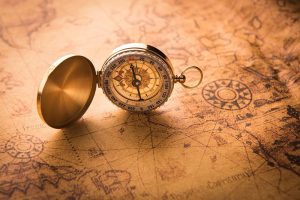10 Interesting Facts About Compasses
Before the discovery of the compass, the position, destination and direction at sea were determined by knowing relief of the coast and the observation of the stars and Sun. Ancient sailors often did not get away from the coast.
Discovery of a compass has made it possible to determine the direction even during cloudy times or on open sea.
Compass is a navigational instrument that reacts to the magnetism of the Earth, and is used for determining sides of the world. Moving magnetic needle is always turning north. The magnetic compass is very simple and accurate and on most journeys we can trust it. We bring you some interesting facts about the compass:
 Fact: An unknown inventor – It is not known who invented the compass, but the first ones who used the magnetic needle to point direction were the Chinese. In 1040 they described how magnetic pins were made.
Fact: An unknown inventor – It is not known who invented the compass, but the first ones who used the magnetic needle to point direction were the Chinese. In 1040 they described how magnetic pins were made.
Fact: Magnetite minerals and water – Most of the early Chinese compasses were made of magnetite minerals that would be bolted like a lace. On this magnetic float, placed in the water, the Earth’s magnetic field would work, so it would always be in the north-south direction.
Fact: Use of magnetite – Needle of the compass was magnetized by rubbing the magnetite, blue-brown ore that came from China and Bengal.
Fact: Origination of name – According to the legend, the word “magnet” derives from the name of the city Magnesia in Asia, there was a magnetite ore site in ancient times. According to another legend, the word originated from the name of shepard Magnus from Crete, who had iron shoes and once stopped on a stone made of magnetic ore.
Fact: Useful improvement in Europe – Around 1300 the maritime compass was already widely used in southern Europe, Scandinavia and Iceland. But at this time the compass got useful improvement – it is placed in a cardanic hinge (two axes connected to the ring brass, allowing it to remain permanently in the horizontal position regardless of the swing of the ship).
Fact: Wind rose – One more important improvement is the introduction of “wind rose”, that is, round tiles with sides of the world and a circle divided into 360 degrees. The “wind rose” would rotate until its northern direction would cling to the north end of the magnetic needle. After that, it was possible to read the ship course correctly.
Fact: William Gilbert experiments – In 1600, physician William Gilbert laid the foundations of today’s knowledge of magnetism. In De Magnete’s work, he describes all the current knowledge of magnetism, lists all the experiments performed, and in one chapter describes the healing properties of the magnetite. William Gilbert made a magnetite ball on which he conducted numerous experiments, finally coming to the conclusion that Earth is a huge magnet with magnetic poles. source: https://nationalmaglab.org/education/magnet-academy/history-of-electricity-magnetism/pioneers/william-gilbert
Fact: North Magnetic Pole – The North Magnetic Pole is located in northern Canada and it’s exactly where the compasses are shown to us. If you are at the top of the magnetic north pole, the arrow will turn into a circle because you are surrounded by a north magnetic field.
Fact: Qibla compass – or qiblah compass is a modified compass used by Muslims to indicate the direction to face to perform ritual prayers. In Islam, this direction is called qibla, and points towards the city of Mecca and specifically to the Ka’abah.

Comments are closed.